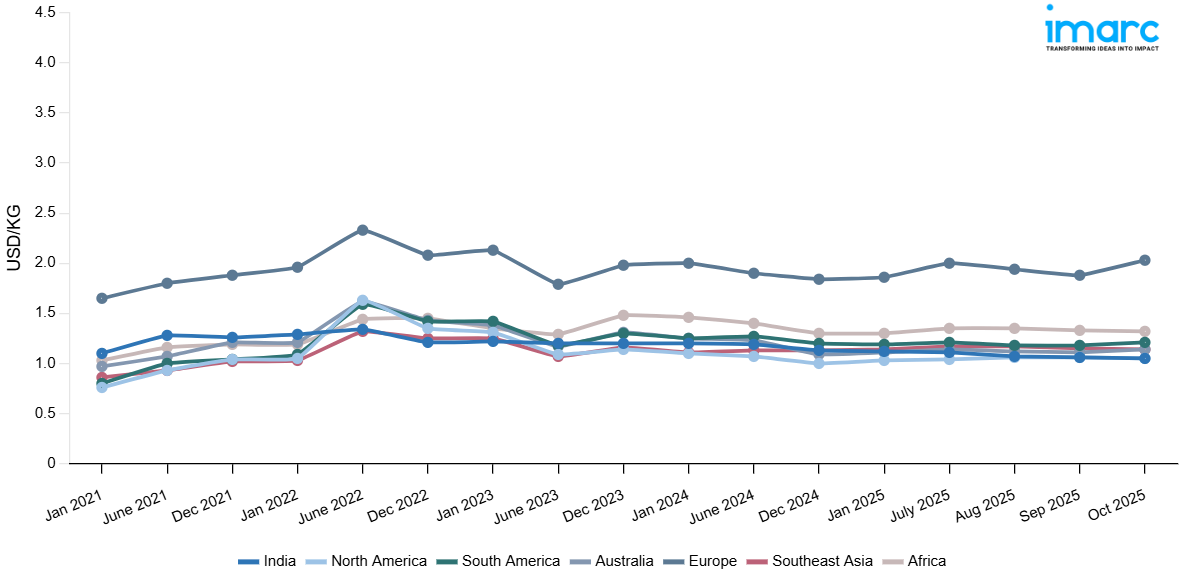
Diesel Prices, Trend, Chart, Demand, Market Analysis, News, Historical and Forecast Data Report 2025 Edition
Diesel Price Trend, Index and Forecast
Track real-time and historical diesel prices across global regions. Updated monthly with market insights, drivers, and forecasts.
Diesel Prices October 2025
| Region | Price (USD/Kg) | Latest Movement |
|---|---|---|
| Africa | 1.32 | -1.2% ↓ Down |
| Europe | 2.03 | 7.7% ↑ Up |
| India | 1.05 | -1.3% ↓ Down |
| South America | 1.21 | 2.1% ↑ Up |
| Australia | 1.14 | 2.0% ↑ Up |
| Southeast Asia | 1.14 | -1.2% ↓ Down |
| North America | 1.05 | -1.4% ↓ Down |
Diesel Price Index (USD/KG):
The chart below highlights monthly diesel prices across different regions.

Get Access to Monthly/Quaterly/Yearly Prices, Request Sample
Market Overview Q3 Ending September 2025
Africa: African diesel markets experienced downward pricing pressures driven by moderating global crude oil benchmarks and improved regional refining capacity utilization. The gradual decline in international crude prices contributed to reduced input costs for diesel production across key markets including Nigeria and South Africa. Supply-side improvements from upgraded refinery operations helped ease regional constraints, though transportation logistics challenges and currency depreciation in several African nations against the US dollar partially offset crude cost benefits.
Europe: The market faced substantial downward corrections as geopolitical tensions stabilized and supply routes normalized following earlier disruptions. The region experienced the most pronounced price decline among all markets, reflecting the unwinding of risk premiums that had elevated prices during previous volatility periods. Adequate refinery output and strategic inventory management supported market rebalancing, while seasonal demand transitions from peak summer travel periods reduced consumption pressures. Carbon pricing mechanisms and renewable fuel blending mandates continued influencing cost structures, though easing supply concerns dominated pricing movements. The combination of normalized logistics and competitive import availability contributed to the pronounced downward trajectory.
India: The market experienced modest downward movements despite projections showing continued demand growth driven by increased vehicle sales and infrastructure development. Government pricing policy adjustments and declining international crude oil benchmarks enabled price moderation, while domestic refining capacity operated at steady levels ensuring adequate supply.
South America: South American diesel markets, particularly Brazil, demonstrated resilience with modest upward pricing momentum. Regional supply-demand imbalances and infrastructure constraints created localized pricing pressures, while refinery operational challenges across several countries limited supply availability. Significant price variations existed across the region, with countries like Uruguay recording substantially higher diesel prices compared to Ecuador. Currency volatility in major economies against the US dollar amplified import costs, while growing demand from agricultural sectors during planting seasons and expanding industrial activities supported the upward trajectory despite global price moderation.
Australia: The market experienced downward pricing adjustments aligned with declining international crude oil benchmarks and seasonal demand transitions. The moderation in global oil prices influenced regional pricing through lower import costs for crude and refined products, as domestic refining capacity limitations necessitated continued import dependence. Improved shipping logistics and favorable currency exchange rates between the Australian dollar and US dollar moderated landed costs throughout September.
Southeast Asia: Southeast Asian diesel markets registered downward pricing movements as spot premiums cooled following surging Indian diesel exports to the region. The influx of competitively priced supplies from India, driven by traders seeking higher Asian profit margins, eased regional supply tightness and moderated pricing pressures. Refinery operations across major markets including Singapore, Thailand, and Indonesia maintained steady output levels, while declining crude oil benchmarks provided favorable input cost conditions. Transportation fuel demand from commercial sectors remained stable, though competitive import dynamics and adequate inventory levels contributed to the observed price decline.
North America: The market demonstrated modest upward pricing momentum despite declining global crude oil trends, reflecting regional supply-demand dynamics and refinery operational factors. Seasonal transitions toward heating oil demand and strategic inventory building for winter requirements supported pricing resilience. Refinery maintenance schedules and normalized supply chain operations balanced market conditions, while regional taxation structures and distribution costs influenced the slight upward movement observed in September.
Diesel Price Trend, Market Analysis, and News
IMARC's latest publication, “Diesel Prices, Trend, Chart, Demand, Market Analysis, News, Historical and Forecast Data Report 2025 Edition,” presents a detailed examination of the diesel market, providing insights into both global and regional trends that are shaping prices. This report delves into the spot price of diesel at major ports and analyzes the composition of prices, including FOB and CIF terms. It also presents detailed diesel prices trend analysis by region, covering North America, Europe, Asia Pacific, Latin America, and Middle East and Africa. The factors affecting diesel pricing, such as the dynamics of supply and demand, geopolitical influences, and sector-specific developments, are thoroughly explored. This comprehensive report helps stakeholders stay informed with the latest market news, regulatory updates, and technological progress, facilitating informed strategic decision-making and forecasting.
.webp)
Diesel Industry Analysis
The global diesel industry size reached 1.44 Billion Tons in 2024. By 2033, IMARC Group expects the market to reach 1.83 Billion Tons, at a projected CAGR of 2.57% during 2025-2033. The market is primarily driven by strong demand in heavy-duty transport, agriculture, and industrial machinery, alongside increasing infrastructure projects in emerging economies. As urbanization accelerates, diesel-powered vehicles and equipment remain essential for logistics and construction activities. Furthermore, advancements in cleaner diesel technologies, such as low-sulfur diesel and hybrid solutions, are gaining traction as part of global sustainability efforts, while evolving regulations in regions like Europe are influencing the adoption of more eco-friendly diesel alternatives to meet emission standards.
Latest developments in the Diesel Industry:
- July 2025: Tatneft, a Russian oil producer, launched a new hydrocracking unit at its TANECO refinery with an annual capacity of 1.2 metric MMtpy. It will produce 0.229 MMt of naphta and 0.64 MMt of low-sulfur diesel.
- May 2025: NYK Group announced the launch of BioxiGuard, Japan’s first antioxidant specially developed for marine biodiesel fuel. The product is made to enhance the oxidation stability of biodiesel.
- October 2024: Baudouin announced its new diesel generator sets tailored for data centres, featuring the M33 and M55 series. With outputs from 2000 to 5250 kVA, these turnkey solutions ensure reliable uptime and performance. Highlighting the upcoming 20M55 model—offering up to 5250 kVA—Baudouin meets the demanding needs of large-scale operators with fully type-tested, Uptime Institute-pre-approved gensets built for efficiency and resilience.
Product Description
Diesel is a petroleum-derived distillate fuel characterized by its amber to dark brown appearance, produced through crude oil refining processes at higher boiling temperatures than gasoline. Primary industrial applications span heavy-duty transportation including trucks, buses, and commercial vehicles, agricultural machinery and equipment, industrial generators and backup power systems, marine vessels, and railway locomotives. Diesel enhances operational performance through superior fuel efficiency compared to gasoline engines, greater torque output for heavy load applications, extended engine durability, and reliable power generation capabilities. The fuel's versatility across transportation, agriculture, construction, and power generation sectors establishes its fundamental role in global economic activities and supply chain operations.
Report Coverage
| Key Attributes | Details |
|---|---|
| Product Name | Diesel |
| Report Features | Exploration of Historical Trends and Market Outlook, Industry Demand, Industry Supply, Gap Analysis, Challenges, Diesel Price Analysis, and Segment-Wise Assessment. |
| Currency/Units | US$ (Data can also be provided in local currency) or Metric Tons |
| Region/Countries Covered | The current coverage includes analysis at the global and regional levels only. Based on your requirements, we can also customize the report and provide specific information for the following countries: Asia Pacific: China, India, Indonesia, Pakistan, Bangladesh, Japan, Philippines, Vietnam, Thailand, South Korea, Malaysia, Nepal, Taiwan, Sri Lanka, Hongkong, Singapore, Australia, and New Zealand* Europe: Germany, France, United Kingdom, Italy, Spain, Russia, Turkey, Netherlands, Poland, Sweden, Belgium, Austria, Ireland, Switzerland, Norway, Denmark, Romania, Finland, Czech Republic, Portugal and Greece* North America: United States and Canada Latin America: Brazil, Mexico, Argentina, Columbia, Chile, Ecuador, and Peru* Middle East & Africa: Saudi Arabia, UAE, Israel, Iran, South Africa, Nigeria, Oman, Kuwait, Qatar, Iraq, Egypt, Algeria, and Morocco* *The list of countries presented is not exhaustive. Information on additional countries can be provided if required by the client. |
| Information Covered for Key Suppliers |
|
| Customization Scope | The report can be customized as per the requirements of the customer |
| Report Price and Purchase Option |
Plan A: Monthly Updates - Annual Subscription
Plan B: Quarterly Updates - Annual Subscription
Plan C: Biannually Updates - Annual Subscription
|
| Post-Sale Analyst Support | 360-degree analyst support after report delivery |
| Delivery Format | PDF and Excel through email (We can also provide the editable version of the report in PPT/Word format on special request) |
Key Benefits for Stakeholders:
- IMARC’s report presents a detailed analysis of diesel pricing, covering global and regional trends, spot prices at key ports, and a breakdown of FOB and CIF prices.
- The study examines factors affecting diesel price trend, including input costs, supply-demand shifts, and geopolitical impacts, offering insights for informed decision-making.
- The competitive landscape review equips stakeholders with crucial insights into the latest market news, regulatory changes, and technological advancements, ensuring a well-rounded, strategic overview for forecasting and planning.
- IMARC offers various subscription options, including monthly, quarterly, and biannual updates, allowing clients to stay informed with the latest market trends, ongoing developments, and comprehensive market insights. The diesel price charts ensure our clients remain at the forefront of the industry.
Key Questions Answered in This Report
The diesel prices in October 2025 were 1.32 USD/KG in Africa, 2.03 USD/KG in Europe, 1.05 USD/KG in India, 1.21 USD/KG in South America, 1.14 USD/KG in Australia, 1.14 USD/KG in Southeast Asia, and 1.05 USD/KG in North America.
The diesel pricing data is updated on a monthly basis.
We provide the pricing data primarily in the form of an Excel sheet and a PDF.
Yes, our report includes a forecast for diesel prices.
The regions covered include North America, Europe, Asia Pacific, Middle East, and Latin America. Countries can be customized based on the request (additional charges may be applicable).
Yes, we provide both FOB and CIF prices in our report.
Need more help?
- Speak to our experienced analysts for insights on the current market scenarios.
- Include additional segments and countries to customize the report as per your requirement.
- Gain an unparalleled competitive advantage in your domain by understanding how to utilize the report and positively impacting your operations and revenue.
- For further assistance, please connect with our analysts.
Why Choose Us
IMARC offers trustworthy, data-centric insights into commodity pricing and evolving market trends, enabling businesses to make well-informed decisions in areas such as procurement, strategic planning, and investments. With in-depth knowledge spanning more than 1000 commodities and a vast global presence in over 150 countries, we provide tailored, actionable intelligence designed to meet the specific needs of diverse industries and markets.
1000
+Commodities
150
+Countries Covered
3000
+Clients
20
+Industry
Robust Methodologies & Extensive Resources
IMARC delivers precise commodity pricing insights using proven methodologies and a wealth of data to support strategic decision-making.
Subscription-Based Databases
Our extensive databases provide detailed commodity pricing, import-export trade statistics, and shipment-level tracking for comprehensive market analysis.
Primary Research-Driven Insights
Through direct supplier surveys and expert interviews, we gather real-time market data to enhance pricing accuracy and trend forecasting.
Extensive Secondary Research
We analyze industry reports, trade publications, and market studies to offer tailored intelligence and actionable commodity market insights.
Trusted by 3000+ industry leaders worldwide to drive data-backed decisions. From global manufacturers to government agencies, our clients rely on us for accurate pricing, deep market intelligence, and forward-looking insights.
 Request Customization
Request Customization
 Inquire Before Buying
Inquire Before Buying
 Speak to an Analyst
Speak to an Analyst Request Brochure
Request Brochure




.webp)




.webp)












